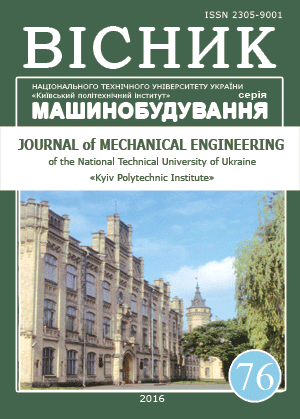EQUIVALENT DIAMETER OF DROPLETS OF SPRAYED WATER JETS AND ITS DEPENDENCE ON TECHNICAL PARAMETERS
DOI:
https://doi.org/10.20535/2305-9001.2016.76.66636Keywords:
fire-fighting water curtain, equivalent diameter of droplets, thermal radiation shieldingAbstract
This work represents further development of earlier received results of simulation of water curtains used as fire protection walls. Subject of the theoretical analysis is the flat fan sprays which flow from the slot-hole sprinkler. The central objective of the study is to develop calculation method of one of the main parameters of this mathematical model. It is such parameter as the equivalent diameter of droplets of the sprayed water stream. Earlier there was no such calculation procedure, and determination of this parameter was made by means of the difficult experimental measurements. Approach. In this study earlier published literary data are applied to calculation of this parameter. The formula received in the work allows carrying out calculation of called parameter on the basis of design characteristics of drencher installation. The graphic dependences constructed on the formula allowed defining dependence of the equivalent diameter of droplets of the sprayed stream on technical parameters. Findings. Application of this formula to earlier developed mathematical model of thermal shielding allowed expanding its opportunities for practical use. This model can be used for designing of water curtains of fire-prevention appointment, and also for definition of optimum modes of their operation.References
Grant, G., Brenton J. and Drysdale, D. (2000), Fire Suppression by Water Sprays. Progress in Energy and Combustion Science, Vol. 26, pp. 79-130.
Meshalkin, E.A., Shevchenko, P.M. (2008), Sostojanie i perspektivy razrabotok izdelij dlja tushenija pozharov tonkoraspylennoj vodoj [State and prospects of development of products for fire suppression by sprayed water]. Pozharovzryvobezopasnost', vol. 17, no 1, pp. 68-75.
Vinogradov, A.G. (2014), Metodika rascheta jekranirujushhih svojstv vodjanyh zaves, Calculation method of water curtain shielding properties, Pozharovzryvobezopasnost', vol. 23, no. 1, pp. 45-57.
Vinogradov, A.G. (2013), Metodyka rozrahunkiv parametriv vodjanyh zavis na osnovi teorii' zatoplenyh strumeniv [Calculation method of water curtain parameters on basis of the submerged jet theory]. Naukovyj visnyk UkrNDIPB (Journal of Research Fire Safety Institute of Ukraine), no. 2 (28), pp. 127-139.
Murrell, J.V., Crowhurst, D. and Rock, P. (1995), Experimental study of the thermal radiation attenuation of sprays from selected hydraulic nozzles. Proceedings of Halon Options Technical Working Conference, pp. 369–378.
Roberts, G.V. (2001), An Experimental Investigation of Thermal Absorption by Water Sprays. Home Office Fire Research and Development Group Report, no 2.
Lin, S.P. and Reitz R.D. (1998), Drop and spray formation from a liquid jet, Annu. Rev. Fluid Mech., vol. 30, pp. 85-105.
Marshall, A.W. and Marzo, M. Di. (2004), Modelling aspects of sprinkler spray dynamics in fires. Process Safety and Environmental Protection, vol. 82, pp. 97-104.
Ren, N., Baum, H.R. and Marshall, A.W. (2011), A comprehensive methodology for characterizing sprinkler sprays. Proceedings of the Combustion Institute, vol. 33, no 2, pp. 2547–2554.
Heskestad, G. (1972), Proposal for Studying Interaction of Water Sprays with Plume in Sprinkler Optimization Program, MA, Factory Mutual Research Corporation, Norwood.
Dundas, P.H. (1974), Technical Report Optimization of Sprinkler Fire Protection the Scaling of Sprinkler Discharge, Prediction of Drop Size, Factory Mutual Research Corporation No 18792 RC73-T-40, Norwood, MA.
You, H.Z. (1985), Investigation of spray patterns of selected sprinklers with the FMRC drop size measuring system. Fire Safety Science – Proceedings of the First International Symposium, Gaithersburg, MD, pp. 1165–1176.
Widmann, J.F. (2001), Phase Doppler interferometry measurements in water sprays produced by residential fire sprinklers. Fire Safety J, vol. 36, no 6, pp. 545–567.
Wu, D., Guillemin D., Marshall A.W. (2007), A Modeling Basis for Predicting the Initial Sprinkler Spray. Fire Safety Journal, vol. 42, pp. 283- 294.
Magnone, Z.L. and Accosta, R.F. (2011), A practical method for designing a virtual sprinkler spray. Proceedings of the Fire and Evacuation Modeling Technical Conference, USA, Baltimore, pp. 1-9.
Huang, J.C.P. (1970), The break-up of axisymmetric liquid sheets. J. Fluid Mech., vol. 43, part 2, pp. 305-319.
Al'tshul', A.D. (1982), Gidravlicheskie soprotivlenija [Hydraulic resistances], Nedra, Moscow, Russia.
Rabinovich, E.Z. (1980), Gidravlika [Hydraulics], Nedra, Moscow, Russia.
Chugaev, R.R. (1982), Gidravlika [Hydraulics], Jenergoizdat, Leningrad, Russia.

